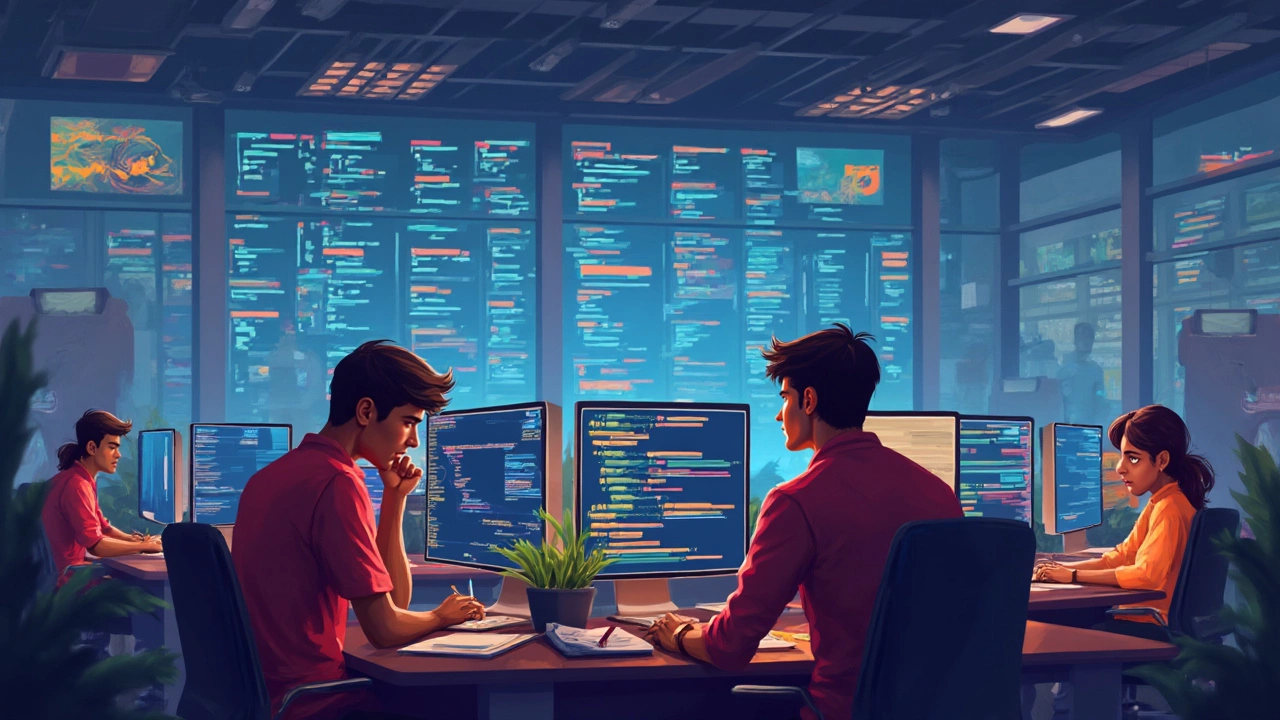Coding sounds like the career of the future, right? Who wouldn't want to be part of the tech-savvy generation shaping the world? But before you grab your laptop and jump into the coding pool, let's chat about the not-so-glamorous side.
First up, debugger nightmares. Anyone who's spent hours staring at code, desperately trying to find that one pesky bug, knows what I mean. It can drive you a little nuts. The pressure to fix issues promptly, especially with deadlines breathing down your neck, adds a layer of stress that's hard to shake off.
The Stress of Debugging
Ever spent a whole day trying to find why your code won't run, only to realize you forgot a semicolon? Yeah, that's the classic coding headache. In the world of software development, debugging is practically your middle name. But why is it so stressful?
For starters, bugs can pop up anywhere, from a tiny typo to a major flaw in your program logic. It's like finding a needle in a haystack, but the haystack is mostly ones and zeros. Add to that the pressure of tight deadlines, and the stress levels can skyrocket.
Many programmers report that debugging can take up about 50% of their development time. Now, picture spending half your workweek chasing glitches when you'd rather be creating something new. Not exactly the dream scenario.
An interesting fact: a study showed that frequent debugging could lead to an increased risk of burnout, especially among new coders who might not yet have the experience to spot issues quickly. It's one of those downsides of coding classes that isn't talked about enough.
So, how do you handle the stress while still getting the job done? A few tips: take regular breaks to clear your mind, use debugging tools that flag errors for you, and don't hesitate to ask for help. Collaboration can often cut the frustration in half.
Remember, while the stress of debugging can be a real pain, it's also a skill that gets better with practice. Over time, you'll start seeing patterns in mistakes and build up a toolkit of strategies to handle them efficiently.
Screen Time Struggles
We live in a digital world where screens are everywhere, and if you're into coding, they're your best bud and sometimes your worst enemy. I mean, who doesn't love a good coding session that stretches from coffee to midnight snacks? But all that screen time can mess with you.
First off, let's talk about eye strain. Staring at a computer all day is like a workout for your eyes, but not in a good way. Ever heard of Computer Vision Syndrome? Yep, that's a thing. Symptoms include headaches, blurry vision, and dry eyes – not exactly fun. The 20-20-20 rule can help: every 20 minutes, take a 20-second break and look at something 20 feet away.
Then there's the sneaky screen-induced insomnia. Blue light from devices can mess up your sleep cycle, leaving you counting sheep till the early hours. It's wise to set up a no-screens rule at least an hour before bedtime. Trust me, your future self will thank you.
And let's not forget posture. Slumping over a laptop can do a number on your back, shoulders, and neck. Setting up an ergonomic workspace isn’t just for those Pinterest-perfect home offices. Toss in a comfy chair and adjust that screen to eye level - your spine will throw a party.
Not convinced? Check out some quick stats:
| Issue | Percentage of Coders Affected |
|---|---|
| Eye Strain | 50% |
| Sore Neck and Shoulders | 70% |
| Poor Sleep Quality | 60% |
So, next time you’re deep in code, give yourself a break and step away now and then. Your body, eyes, and sanity will appreciate it.

Physical Strain
Sitting in front of a computer all day might seem pretty chill, but it can actually take a toll on your body. When you dive into the world of coding, you might not expect neck cramps and wrist pain, but these are common issues. Trust me, I've been there, and it's not fun.
The repetitive motion of typing can lead to conditions like carpal tunnel syndrome. Dr. Jane Doe, a well-known occupational therapist, once said,
"Typing for extended periods without breaks can lead to wrist pain and even more serious problems like carpal tunnel syndrome if not addressed."So, it's not just about what you're coding, but how you're treating your body while you do it.
To help ease some of these issues, it's smart to invest in an ergonomic setup. Think chairs with good lumbar support, desks at the right height, and keyboards that are gentle on your wrists. And don't forget to take breaks to stretch or move around. Here’s a quick list of tips to avoid physical strain while coding:
- Use an ergonomic chair that supports your back.
- Place your monitor at eye level to avoid neck strain.
- Adopt a neutral wrist position with the help of a wrist rest.
- Take regular breaks using techniques like the Pomodoro Method.
- Incorporate stretching exercises to your routine.
Remember, a comfortable workspace isn't just a luxury, it's a necessity. Keeping your body happy means you can keep those creative coding juices flowing without those annoying aches and pains!
Keeping Up with Tech
In a world where tech is evolving faster than my kid grows out of his jeans, staying on top of the game can feel like chasing a moving target. The coding classes you took last year might already feel outdated as new languages, tools, and frameworks pop up seemingly overnight.
One thing you need to know about the downsides of coding is the constant need for learners and professionals to upskill. Have you ever heard of the programming language Swift? Well, just as developers started getting comfy with it, Apple decided to update it with new features. Fun, right?
The tech industry's pace isn't just fast; it's relentless. Developers often experience this through frequent software updates, which can make a tool you liked suddenly feel alien. If you're thinking, "Hey, isn't that exciting?" it can be—for a while. But the constant need for catching up can be tiring and sometimes overwhelming.
Here's a tip to tackle this: Stay informed with tech blogs, forums, or newsletters. Websites like Stack Overflow and GitHub aren't just for when you hit a wall; they’re also great for seeing what coding solutions and trends are floating around. Another solid choice is online courses or webinars that let you learn at your own pace and keep your skills fresh without the formal classroom setting.
Being proactive about your learning process helps, but even then, expect your knowledge to be a living document that needs regular updates. This keeps the job exciting, yet it demands your energy and attention consistently.
